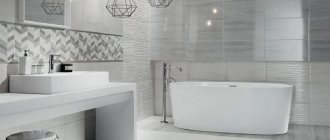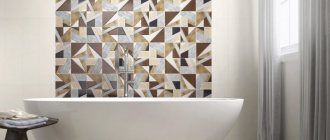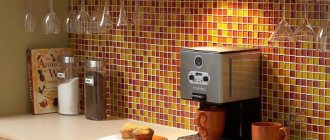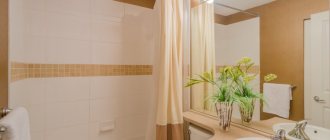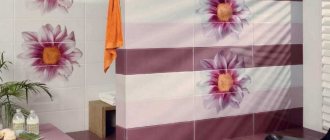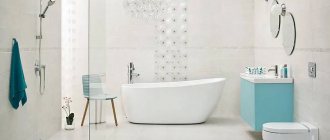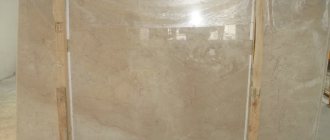At the moment, when choosing finishing materials for the bathroom, most owners of apartments and private houses focus on ceramic tiles. This decision is easily explained, because the material has a number of advantages, including practicality, attractive appearance, ease of maintenance and excellent performance properties of the tile.
Thanks to the wide range of prices, colors, shapes and sizes, everyone can choose the most suitable material for decorating the room. The most difficult thing to decorate is a small bathroom, because you need to carefully select tiles based on their physical properties. The main task when creating the interior design of a small bathroom with tiles is to visually increase the space.
What size tiles should I choose for a small bathroom?
If you take into account a few subtleties, you can lay tiles of any size. To complete the finish, it is advisable to combine different products. But in the end, it all depends on the preferences of the apartment owner, even if it is a small bathroom in a Khrushchev-era building.
- Large products (for example, 30x40) are laid horizontally; this method will visually expand the walls. The grout for the joints should be chosen in a tone so as not to split the space with thin contrasting lines.
- Medium sized tiles (20x30, 30x30) are the best option for a small bathroom.
- Products of small sizes (these include “boar” 10x20 and square 10x10) can split up the space if you use different colors and contrasting grout. It is recommended to choose a single-color material, due to which the room will visually come together.
The photo shows large-format tiles with inconspicuous grout to match.
- Mosaics are usually used to decorate one wall or, for example, a shower stall. If you want to decorate the entire room with mosaics, it should be the smallest and lightest shades in order to create a general background without affecting the geometry.
The photo shows a combined bathroom, the walls of which are decorated with ceramic mosaics interspersed with mirror ones.
Large or small?
Stylish designs dispel the myth that it is irrational to use large tiles for tiling small rooms. By correctly positioning the tiles, you can visually add volume to the room. Just don’t decorate the entire surface with it.
Add volume to a room with tiles
An excellent option would be to lay vertical stripes of large rectangles or squares in the center of a large wall. A 20x50 cm tile with a pattern on the floor in the center of the room will create the illusion of carpeting.
Large rectangles in the center of the wall
Products with a glazed surface narrow the space.
Unusual tiles to create a cozy bathroom
Using large tiles to decorate a small bathroom is possible, but difficult, so medium and small sizes are considered the most suitable:
- 10x10 cm models are suitable for the design, but it should be remembered that the dark range visually “eats” the actual dimensions and looks somewhat gloomy;
Models 10x10 cm fit the design
- the perception of 20x20 cm squares is practically not affected by their shade or design, the main role is played by the visual impression;
Visual impression with size 20x20
- mosaic allows you to create original ornaments of different options, but requires accurate calculations.
Original mosaic panel
It is believed that the correct size and shape have a more pronounced effect of increasing the volume of space than the color palette. If the bathroom is narrow, a large tile size will reduce the number of conventional lines and create a visual effect of spaciousness.
The effect of increasing space due to tiles of the correct shape
The optimal tile size for a rectangular bathroom of modest size is considered to be rectangles of 20 by 30 cm, and for a square one - 20 by 20 cm.
The optimal size for tiles is 20 by 30 cm
It is better to lay it across, rather than parallel to, the shape of the ceiling surface.
This will be interesting to you: REVIEW: Decorating the Bathroom with artificial stone: Washbasin, countertop, shelves. Features of using the material
Recommendations for choosing tile color
Designers do not recommend decorating a small bathroom with products in dark colors. You need to choose neutral shades: white, sand, blue, light green, gray. When combining different colors, it is also recommended to use muted tones.
Products of a rich palette are appropriate as decoration for niches, mirrors, and a bath screen: the choice depends on taste preferences and the layout of the room.
The warmer the more fashionable
Fashionable warm colors include:
- yellowish;
Yellowish shades in bathroom elements and decor
- peach;
Natural shades in your bathroom
- sand;
Fashionable sand for bathroom wall decoration
- beige.
Elegant beige shade for wall decoration
A combination of several tones of this series looks impressive, preferably with a horizontal delimitation of the color palette. The expansion of space is facilitated by the placement of dark narrow stripes at the top and bottom, which do not change the predominance of the background of a light palette.
Several tricks for successfully expanding space
If you want to visually “raise” the ceiling of the room, it is important to design narrow vertical stripes on both sides of the wall. A combination of these two techniques is not excluded.
The lines in the center of the wall will help raise the ceiling
To highlight a certain area of the wall, dark colored inserts are used. This illusorily brings the highlighted part closer.
Highlight a wall using dark accents
Selecting the right tile design to increase space
To distract attention from the modest size of the bathroom, designers offer several interesting ideas. For example, you can lay out the same tiles on both the walls and the floor, unifying the space. Or vice versa: make the flooring rich in color - it will draw attention to itself - and decorate the walls in neutral colors. The same technique works with bright furniture and accent elements.
Be sure to look at other ideas for visually enlarging a room.
In the photo, the small bathroom is visually expanded due to the same coating on the wall and floor.
In a small bathroom, you can also combine local areas, for example, a shower room and the floor.
The photo shows compact bathrooms with wide marbled tiles.
Relief and ornament - creative and stylish
Decorative accents enliven the design and create a feeling of completeness. In a small bathroom this task can be accomplished by:
- tiles imitating fabric;
- vertical and horizontal elements with a pattern;
- friezes or borders.
Patterned borders in your bathroom
The number of compositions is minimal. They should complement the decor, but not stray from the unified concept. Shiny particles of gold and silver increase the attractiveness.
The use of elements with convex relief, especially models with a 3D effect, creates the ultimate expansion effect, but only when decorating small areas of the wall. Embossed tiles on the entire surface will cause the opposite reaction.
Embossed with 3D effect
Drawings or ornaments on the tiled flooring add personality to the decor, but a small bathroom will look smaller if you decorate it with large, colorful panels. In such a room, a dim image made of tiles that are the same size as the main cladding is relevant. It is preferable to place not a picture on the wall, but small patterns on each segment of the material.
Ornament for individual design
A surface made of light tiles at the top with tiles a tone darker at the bottom, divided horizontally by a decorative pattern, looks stylish. And at any level. The room seems wider and more spacious.
What type of surface to choose: glossy or matte?
Any coating is suitable for a small bathroom, but each has its own characteristics:
| Glossy | Matte |
| Visually increases the area of the room, giving depth. | Used in interiors where gloss is inappropriate. |
| Shiny tiles reflect light, expanding the space. Suitable for walls. | The rough texture of ceramic tiles is safer and therefore suitable for floor coverings. |
| Water drops and handprints are more noticeable on it, but the surface is easy to clean. | On a matte finish, plaque is less noticeable, but it is also more difficult to wash. |
Since the purpose of decorating a small bathroom is to expand the space, glossy products are preferable.
The photo shows a glossy “hog” that adds depth to the space in a small bathroom.
Texture Features
Modern ceramics are diverse not only in size, decor, but also in the texture of the front surface. There are tiles only for wall or floor cladding, universal models that are suitable for both coverings. Products presented with the surface:
- glazed;
- unglazed;
- glossy;
- matte.
Shiny ones are suitable for small rooms. Gloss helps to visually increase space. The glazed surface is easy to clean and wash.
Moreover, it is affordable. Therefore, an option for a small room would be tiles with two layers of glaze and small protrusions. This surface looks very original.
Shiny for small spaces
Glass and mirror materials will require more frequent cleaning, but in combination with other materials they will give the atmosphere lightness, airiness, and spaciousness.
Glass for an airy interior
This will be interesting to you: REVIEW: Bathroom furniture: Features of choosing Sinks with a cabinet - how not to make a mistake? (190+ Photos)
Which tile shape is best?
The modern market of ceramic tiles is replete with a variety of shapes. But not all options will look good in a small bathroom.
Standard rectangles and squares emphasize the geometry of the room and look unobtrusive: just what you need for a small room. Walls with voluminous, relief or hexagonal tiles look impressive and attract the eye, but you should not overload the space with them.
Check out our bathroom tiling options.
The photo shows rectangular brick-like tiles in a milky shade.
Products of irregular shape (for example, scales) or triangles are suitable only for decorating individual areas.
Color shades
It is generally accepted that to decorate a small bathroom, it is better to choose a shade of white, but this theory is not entirely true.
With a large presence of white shades in the room, the bathroom looks too simple, with a boring environment, while many people associate it with a hospital ward.
I would also like to note that the effect of visual expansion of the room’s territory will not be visible, only the illumination of the room will increase. You need to know that white color goes well with other light colors and tones.
Bathrooms with a window: varieties, design optionsBeige bathroom: options for color combinations and examples of a bathroom in beige tones
- Bathroom accessories: photo review of fashionable designer new items
Design experts do not recommend using dark colors in small bathrooms, as they can be too depressing and lead to a visual reduction in space in the room.
If suddenly the owner wants to decorate the bathroom interior in dark shades, for this it is best to choose not very dark shades. This will give the opportunity to add depth to the bathroom.
How does layout affect a small bathroom?
Here everything depends on the proportions of the bathroom: the layout can lengthen the space or expand it. Long horizontal products expand the walls. The same effect is achieved by lines of contrasting tiles, ceramic or glass mosaics.
Vertically laid tiles visually raise the ceilings.
The photo shows narrow wood-look tiles laid out along the wall.
A diagonal arrangement gives an interesting effect in a small bathroom.
Attention to the method of laying tiles
For the correct perception of space, not only the design of the tiles is important, but also the way of laying elements on the walls. To decorate a small space, it is better to use the simplest option.
This is a linear fixation without displacement. From a design point of view, it is a bit boring, but will not have a negative impact on the interior. More interesting options for laying diagonally and in a running direction will emphasize the depth of the space, help the eye to “catch” better, but risk visually narrowing the room.
A selection of ideas for a small bathroom
If a plain white bathroom seems boring, you can decorate the border or lay out a pattern with contrasting elements. Bright accents add completeness to the interior. A decor made from parts with a finished pattern would be appropriate.
Be sure to look at how you can tile a toilet.
By combining different colors and textures, you can “dissolve” the extra corners that appear as a result of combining a bathtub and a bathroom. The classic black and white combination looks impressive in the interior of a small bath.
Practical functionality
Compact devices. A built-in, wall-hung toilet saves a lot of space; using a shower cabin instead of a sit-down bathtub, you can carve out additional square meters.
Many manufacturing companies produce washing machines no more than half a meter wide. This option is ideal for a small bath combined with a toilet.
Tile texture for a small bathroom
Both size and decor are important when choosing. However, the texture design is of considerable importance. The assortment usually includes a material that is intended exclusively for walls or floor surfaces, and there are also universal models.
The surface of the top layer can be:
- With glaze;
- Without her;
- With a matte effect;
- Glossy.
A small room usually looks better if there are reflections in it, especially since the glossy surface illusorily expands the space.
So, according to experts, the best choice would be a tile that has a two-layer glaze applied and also has very small bulges. Such tiles will add originality in the required amount.
Mirror material, along with glass, can be perfectly combined with other types of decoration, giving the room a light airiness. Although they will need to be cleaned more often.
Tools and materials
When choosing a cladding material for a bathroom, you must take into account the following characteristics:
- technical parameters - strength, abrasion resistance, surface smoothness or porosity, chemical resistance. Thus, ceramic floor tiles for the bathroom should be highly wear-resistant and have a non-smooth surface;
- aesthetic parameters - color, ornament, compliance with the style of the room being designed;
- size and correct geometric shape.
Ceramic tiles come in various types, depending on the manufacturing method:
- bicottura are glazed ceramic tiles for interior wall cladding; their surface is double fired. Metlakh tiles made from quarry clay are also double fired. Not suitable for floor coverings. Glazed ceramic tiles for interior wall cladding are very durable, but their smooth surface is not suitable for laying on the floor. The exception is relief tile glaze;
- monocottura - single-firing tiles. Durable, suitable for flooring;
- the most durable tile is clinker, usually used for laying on the floor, its appearance resembles a brick;
- mosaic – small tiles glued to a mesh;
- porcelain stoneware imitating natural stone;
- glass and mirror tiles for walls and ceilings. It is subject to mechanical stress, so you cannot lay the floor with it.
Mosaic Mirror Clinker Bicottura Porcelain Tile Monocottura
The amount of tiles is calculated as follows: you need to divide the surface area of the bathroom by the area of one element and add 10-15 percent for the margin (undercuts, defects, defects when cutting the material).
In addition to tiles, you will need the following materials:
- tile adhesive;
- primer, which should have antifungal additives;
- joint grout;
- spacers (crosses) to regulate the thickness of the joints between the tiles;
- silicone sealant;
- bathtub sealing tape;
- masking tape.
Do not forget that all materials used to make up ceramic tiles must be moisture resistant. The tools you will need are tools for applying and mixing the solution: a rubber or notched spatula for grouting, a container for primer and glue. Cutting tiles is carried out with a tile cutter, grinder or ordinary glass cutter, depending on the thickness and strength of the tile. In order to sand the edges of the tiles, you will need sandpaper. A rubber mallet is needed to tap the material so that it adheres tightly to the adhesive base. You also cannot do without a building level, a wooden strip to support the bottom row of tiles, as well as bricks, if necessary, to lay the screen space under the bathtub.
Floor covering
Linoleum and laminate are not the best options for bathroom floors.
- In the event of a serious leak, this coating will require replacement. Ceramic tiles or porcelain tiles would be the best option.
- They are resistant to mechanical stress and moisture. For the bathroom, choose a product with a rough surface, without a glossy sheen.
- This coating will protect you from the danger of slipping on a wet floor. The color of the flooring should be the same color as the wall tiles or a little darker.
Photos of a small bathroom will help you decide on a color scheme.
Advice! Experts do not recommend choosing white grout for grouting floor tiles, as it will quickly lose its attractive appearance.
Joint or divided
Separated bathrooms and showers are rare in modern apartments and there is no need to talk about zoning or compact arrangement, since the rooms do not exceed 1-1.5 square meters. m.
A wide variety of design options are developed for small baths with a toilet. You can’t fit a lot on 2-5 square meters. Here it is necessary to take a more careful approach to the choice of furnishings and initial planning is required in order to clearly see the arrangement of furniture and distribute free areas for passage.
Ideas for combining tiles
Pure white tiles are not particularly good for decorating an entire room. At the same time, the interior looks somewhat boring and gives off the appearance of an institution related to medicine. This will not increase the space, only the illumination will become more noticeable. But when combined with another palette, it gives a wonderful effect.
The following shades go well with it:
- Terracotta color;
- Grayish-pearl;
- Bluish or bluish in light colors;
- Greenish, slightly muted;
- Lemon or light yellow palette;
- Peach color;
- Shades of mountain lavender;
- Sand option.
Creativity can be created with the help of stripes arranged in a chaotic vertical order.

